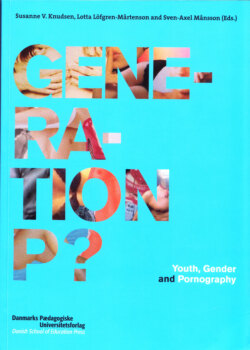Читать книгу Generation P? - Группа авторов - Страница 21
На сайте Литреса книга снята с продажи.
Hyperreal sexuality
ОглавлениеSeduction lies in the transformation of things into pure appearance (Baudrillard 1990 [1977], 117).
When everything is sexual, nothing is sexual any more and sex loses its determinants (Baudrillard 1993a, 9).
The historical process Foucault analyzes in the first volume of The History of Sexuality. Will to Knowledge focuses on the scientification of sexuality that is taking place in modern society. Today, the scientific apparatus – particularly the disciplines of medicine, sexology and psychology – is mapping and exploring all the nooks and crannies of sexuality. If we move on to a contemporary theorist and philosopher such as Jean Baudrillard, we find ourselves in the media age, a period that Foucault was not able to write about and analyze. Talk about sexuality is now transformed into talk about the flow of pictures and phantasms produced and distributed via various media (Baudrillard 1990 [1977], 1993a,b).
Owing to the recent popularity of ‘the confession’, we have now developed our knowledge of most aspects of human sexuality. In many fields, not least pornography, sexuality has been penetrated, explored and colonized. It is hard to imagine being able to shock people today – getting them to react strongly to how sexuality is portrayed and stressed in the public sphere. Even so, moral reactions and even moral panic do still occur, but they die out rather quickly and disappear in the media roar. The fact that people cannot be shocked, however, does not imply a lack of prejudices, moral stands or repressive outlooks on sexuality in our society. These phenomena are simply manifested in ways other than the classic Victorian variation on sexual morality.
When sexuality achieves total penetration and becomes an ingredient in everything from soap operas, talk shows and of course the internet, what is there left to keep secret or protect? When seduction becomes an increasingly abstract process – a kind of hallucinatory pleasure of the signs, a fascination with the superficial or with the intrusive cameras’ pictures of genitals in action – what is there left to be seduced by? Baudrillard takes us to the end of the journey. According to him, when we have done all this, we have also eradicated what we used to call sexuality. The sexual is emptied of all meaning, but we are still left with our fascination, our expectation that there are more limits to be exceeded and that the search must continue.
Today every detail is included in obtrusive portrayals of people’s sexual existence. Current media technology provides undreamt possibilities to conduct exhaustive studies of human beings’ physical relations. To be sure, this total demystification of human sexuality also defuses it, but the fall-out of this is new mythologies, new fantasies and new attempts to make the sexual secret. These novelties, however, only constitute temporary barriers to the hyper-real exploration of sexuality, as they are soon drawn into the media roar (Johansson 2007).
The scientific revolution and successful exploration of sexuality during the 19th and 20th centuries constituted one of the starting points of the continued study of sexuality during the latter half of the 20th century. Today, scientific observation is supplemented by the media’s capacity to penetrate even more deeply all aspects of sexuality. In talk shows, for example, various aspects of sexuality are literally talked to pieces, and the talk is only part of it: pictures are also used to study in detail different kinds of facial expressions, body movements and emotional responses. Yet while boundaries, distinctions and moral norms are disintegrating in the media world, we can sometimes see in everyday life that a repressive, normative sexuality is gaining a greater foothold. How can we reconcile this?
Baudrillard would probably not have concerned himself with discussing the relation between a simulated reality, for example the media world, and our social reality. What he stresses is how the form itself shapes our perception and our consciousness – that the medium is the message. Today, we must also problematize both the images of the media world and of life lived in everyday reality. Though we are able to observe increased experimentation with sexuality in the media, we also see signs of an opposing trend, including the cultivation of a number of very traditional conceptions of gender and sexuality (Hammarén & Johansson 2002, Johansson 2007). Thus, in this way, we may say that everyday life is both conservative and radically pioneering.
